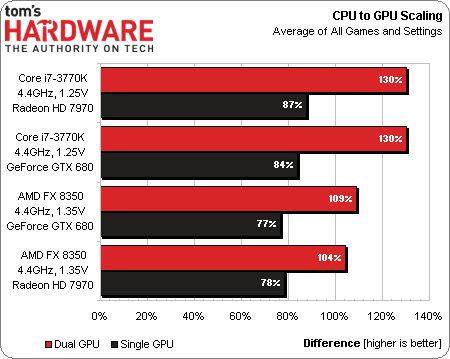CrossFire Versus SLI Scaling: Does AMD's FX Actually Favor GeForce?
We've heard it said before that AMD's GPUs are more platform-dependent than Nvidia's. So, what happens when you drop a Radeon and a GeForce into an FX-8350-based system? Does AMD's CPU get in the way of its GPU running as well as it possibly could?
How Does FX Treat Your Graphics Card?
Does AMD’s flagship CPU really allow GeForce cards to run closer to their potential than Radeons? That conclusion is still a little difficult to reach, since the Radeon HD 7970 is faster than the GeForce GTX 680 in today's benchmark suite. We can still get there by comparing the results of a less-bottlenecked processor, however, and we can get even more information by comparing CrossFire to SLI. After spending way too much time poring over the data, the best illustration of CPU-to-GPU scaling occurred as I wrote this article’s introduction.

The above chart shows that, without significant CPU bottlenecks, two GeForce GTX 680s in SLI and a pair of Radeon HD 7970s in CrossFire offer similar performance. It also illustrates that this performance similarly comes not from having identically-performing cards, but from a slight scaling advantage favoring the slower GeForce GTX 680s when you put two of them together.
Our big revelation is that AMD’s FX-8350 performs 5% better in SLI than it does in CrossFire. When all else is made equal, AMD’s current flagship host processor really does favor Nvidia's graphics technology. Whoops.
Get Tom's Hardware's best news and in-depth reviews, straight to your inbox.
Current page: How Does FX Treat Your Graphics Card?
Prev Page CPU-To-GPU Performance Scaling